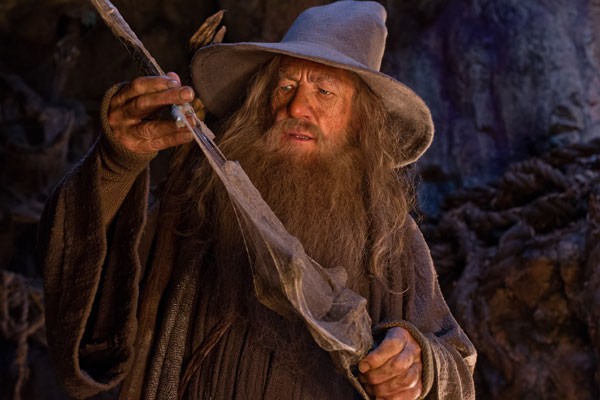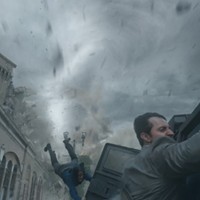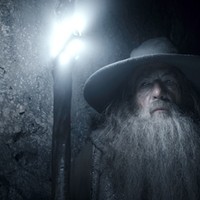THE HOBBIT: AN UNEXPECTED JOURNEY
***
DIRECTED BY Peter Jackson
STARS Ian McKellen, Martin Freeman

-
Martin Freeman as Bilbo Baggins (Photo: Warner Bros. & MGM)
When 20th Century Fox debuted the revolutionary widescreen process CinemaScope with 1953's The Robe — thereby allowing the medium to successfully distinguish itself from new-kid-on-the-block television and its boxy images — the critic for the New York Daily News responded by giving the movie eight stars: four stars for the film itself and four stars for CinemaScope. I'll refrain from similarly adding any more celestial icons to my ratings — with all those pointy stars hanging around, I might poke my eye out — but I will concede that a radical new process available at select theaters showing The Hobbit: An Unexpected Journey does deserve a review of its own.
Moviegoers will have a buffet of viewing options to consider when purchasing tickets for The Hobbit: 2-D or not 2-D; the eye-popping spectacle of 3-D; the larger-than-life essence of IMAX. And now we can add High Frame Rate (HFR) into the mix. Instead of merely offering the flick in the normal 24 frames per second, director Peter Jackson has opted to make motion picture history by fashioning The Hobbit as the first movie completely filmed and projected at 48 frames per second. His intention is to take film to another level with this concept, which basically heightens the reality of the image to such a startling degree that the moviegoing experience becomes even more immersive — operating in tandem with 3-D, it allows viewers to feel as if they're visiting the home of hobbit Bilbo Baggins themselves, or traipsing across the landscape and able to give Gandalf a helping hand should he trip and fall.
But is this a good thing? Not unless the title had been Days of Our Hobbits or As the Shire Turns. While the clarity is absolutely staggering, the image itself is flattened out to the point that everything resembles the sorts of efforts usually played on TV screens: soap operas, home movies, shot-on-video shorts. Instead of planting us squarely in Middle-earth topography, the 48fps format effectively serves to distance us from what's occurring on screen, and scenes that no doubt pop (or at least move) in the traditional 24fps mode often feel awkward and draggy, resembling more closely a high school amateur night than something orchestrated by a master filmmaker like Jackson.
On a related note, it's been widely reported that the 48fps format has caused motion sickness in numerous audience members. My daughter didn't feel it at all while it only took me about half a minute to get accustomed to this new way of watching a movie — apparently, we were the lucky ones. Perhaps the studio will capitalize by having theaters sell Bilbo Baggins Barf Bags™ alongside the Twizzlers and large Cokes.

-
Ian McKellen as Gandalf (Photo: Warner Bros. & MGM)
My advice, then, would be to see the movie in 2-D or even regular 3-D and leave the 48fps nonsense by the wayside, thus allowing one to accept the movie on its own merits, without any pesky distractions. To that end, Jackson and his collaborators have made a film that's often entertaining but can never quite shake the stigma of being a footnote to The Lord of the Rings trilogy that earned billions of dollars and won handfuls of Oscars. Opting to divide J.R.R. Tolkien's The Hobbit — a slim work when compared to the gargantuan LOTR — into three films reeks of a cash grab even more than splitting the final Harry Potter and Twilight books into cinematic two-parters, but considering the piece gathers steam after a lethargic opening, it seems likely that the subsequent entries will maintain the stride and emerge more balanced.
In this prequel to the Rings trilogy, Ian McKellen again portrays the wise wizard Gandalf, electing to help a gang of dwarves take back their home (and all the riches therein) from the fearsome dragon Smaug. Gandalf's intuition tells him that the dwarves will only succeed in their task if the hobbit Bilbo (Martin Freeman) accompanies them on their journey. A homebody averse to adventure, Bilbo reluctantly agrees to join the band of merry men, and soon they're off coping with orcs, trolls, rock creatures and CGI wolves borrowed from the Twilight hard drive.
Because he's swelling this tale out to three movies that will each doubtless clock in near the three-hour mark (this first one's 168 minutes), Jackson treads a lot of water, never more obviously than in the prolonged early stretch when the dwarves first meet Bilbo by invading his home like American Pie teenagers searching for a house party. Once the group bids adieu to safety and comfort, though, the movie picks up with an endless stream of action set-pieces. While there's theoretically a sameness about the setups (band sees impending danger, band runs, band is forced to fight, band is saved at last moment, repeat cycle), Jackson expertly stages each one in a way that cumulatively reaches its crescendo with a climactic battle against some particularly nasty orcs.
Perhaps in an effort to further bridge this film with The Lord of the Rings (or, again, maybe just to pad the running time), Jackson and his co-scripters include familiar faces that weren't even in Tolkien's book of The Hobbit. Frodo (Elijah Wood), the older Bilbo (Ian Holm), Galadriel (Cate Blanchett) and Saruman (Christopher Lee) all turn up, and their appearances are superfluous in the extreme. On the other hand, Gollum (Andy Serkis) does appear in Tolkien's text, and his scene here, confronting a lost Bilbo, is one of the highlights of the film.
The next two pictures, The Hobbit: The Desolation of Smaug and The Hobbit: There and Back Again, will be respectively released in December 2013 and July 2014. We know that 48fps will hang around at least through those efforts — and maybe beyond, since James Cameron has stated that he plans to use it for Avatar's two sequels. In the long run, though, let's hope it lands on the trash pile of cinema history, alongside Smell-O-Vision, Sensurround, Duo-Vision and other equally ill-advised gimmicks.



